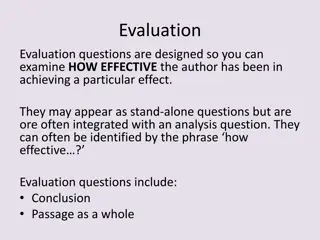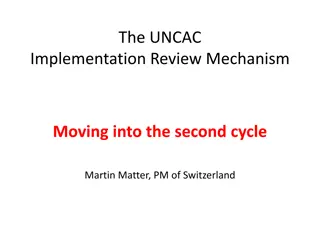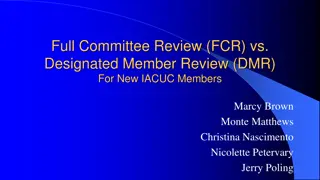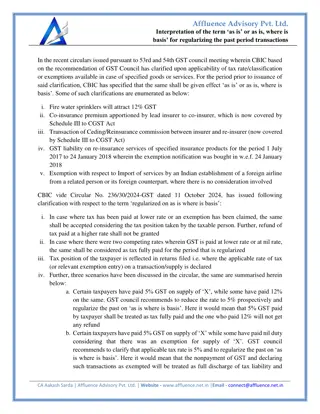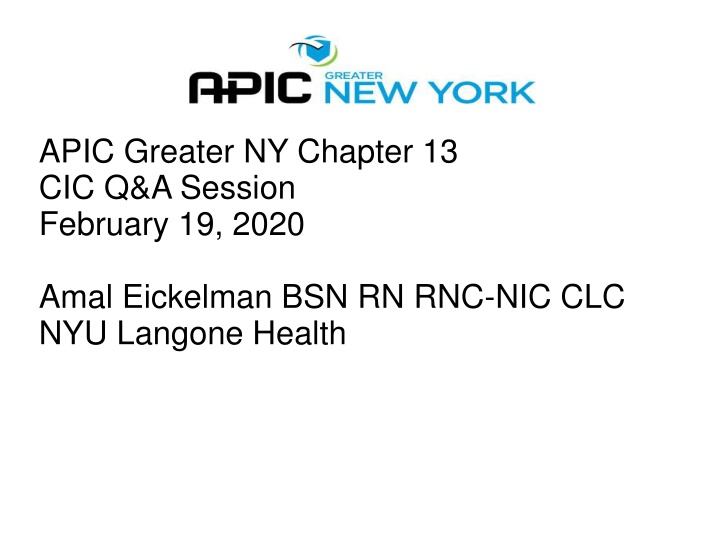
CIC Q&A Session: Infection Control FAQs Answered
Discover answers to common infection control questions, including calculating CAUTI rates, contact times for disinfection, and examples of passive transmission. Gain valuable insights from the APIC Greater NY Chapter session.
Download Presentation

Please find below an Image/Link to download the presentation.
The content on the website is provided AS IS for your information and personal use only. It may not be sold, licensed, or shared on other websites without obtaining consent from the author. If you encounter any issues during the download, it is possible that the publisher has removed the file from their server.
You are allowed to download the files provided on this website for personal or commercial use, subject to the condition that they are used lawfully. All files are the property of their respective owners.
The content on the website is provided AS IS for your information and personal use only. It may not be sold, licensed, or shared on other websites without obtaining consent from the author.
E N D
Presentation Transcript
APIC Greater NY Chapter 13 CIC Q&A Session February 19, 2020 Amal Eickelman BSN RN RNC-NIC CLC NYU Langone Health
Q1 When calculating rates of CAUTI on a unit in a six-month period, the denominator must include: A) All patients B) All patients with urinary catheters C) All patients with CAUTI D) All patients with urinary catheters minus those with CAUTI
Answer 1: B When calculating rates of CAUTI on a unit in a six-month period, the denominator must include only those at risk. In this case, the denominator would include all patients with urinary catheters and exclude all others. The numerator is the number of events or CAUTIs that occurred. Rates measure the probability of an event (such as a CAUTI) occurring and may be utilized to compare different populations. Rates include incidence, prevalence, point prevalence, and attack
Q2 What is the usual contact time for low-level disinfection of noncritical patient environmental surfaces and equipment: A) 1 Minute B) 5 Minutes C) 10 Minutes D) 15 Minutes
Answer 2: A The usual contact time for low-level disinfection of a noncritical patient environmental surfaces and equipment is one (1) minute. The CDC recommends this time period, but the EPA requires following of directions on the EPA-approved labels, so some recommend a longer time period, such as 10 minutes. However, since liquid disinfectants typically dry in 1.2 to 2 minutes, this would require repeated applications, so the one-minute timeframe is usually followed. The thoroughness of the cleaning is more important than the duration of disinfection.
Q3 Which of the following is an example of passive or indirect transmission: A) Eating chicken infected with Salmonella B) Eating food contaminated with hepatitis A C) Breathing in droplets of someone infected with influenza D) Having unprotected sex with a person with HIV
Answer 3: B Passive or indirect transmission occurs when an organism is present and does not replicate within the source, such as when hepatitis A contaminates food that someone then eats, resulting in infection. The hepatitis virus does not replicate in the food, so the loading dose is generally small. Salmonella, however, replicates in chicken, so it produces a large loading dose, which spreads infection to someone ingesting the meat, and is an example of active direct transmission from a common source.
Q4 A group of staff on one hospital unit cooperated to develop a plan to implement preventive strategies, resulting in a 50% decline in SSI with subsequent adoption of these strategies by other units. This is an example of: A) Social support system B) Positive deviance C) Modeling D) Mentoring
Answer 4: B Positive deviance is a behavioral approach to change that is based on the fact that some individuals or groups develop methods that results in better outcomes than others and that others can learn from these deviations. Positive deviance is based on four steps: Define the problem Determine the presence of positive deviance Discover the practices or behaviors the deviants use Design a program based on those practices When another unit utilizes the practices developed by the group exhibiting positive deviance, this is referred to as scaling up.
Q5 According to the second IOM (Institute of Medicine) report, Crossing the Quality Chasm: A New Health System for the 21stCentury, the primary aim of the healthcare system should be on: A) Efficiency B) Patient safety C) Equity D) Effectiveness
Answer 5: B While all of these are important, the IOM states that the primary aim of the healthcare system should be on patient safety with safe care provided in a safe environment. While errors occur, the goal is to prevent harm to the patient as well as the harm to the healthcare provider. The IOM also stresses the importance of patient- centered approaches that consider the values and needs of the patient, effectiveness that relates to use of evidence-based care, efficiency, and equity.





